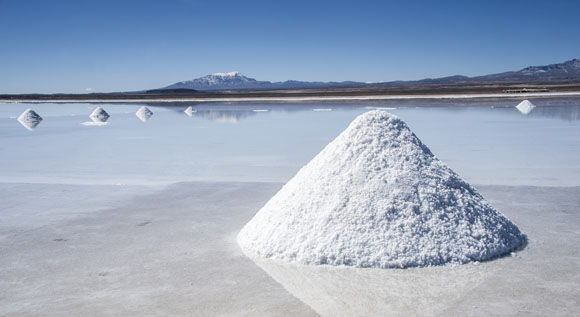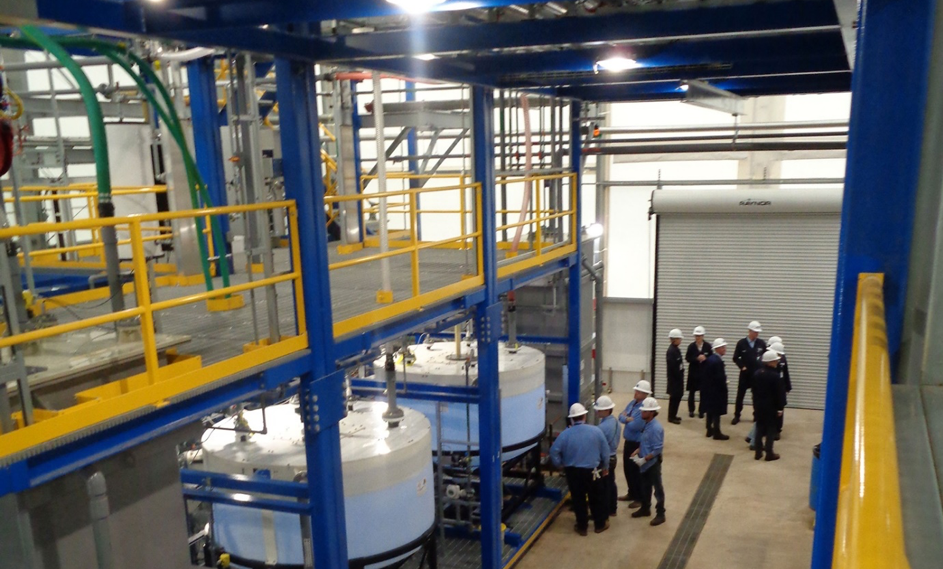The Mining Report: Economic growth rates have diverged this year. They're increasing in the U.S. and slowing down in China and India. They're stagnating in Europe, and Russia is going into recession. How is all that affecting the lithium space?
Daniela Desormeaux: The lithium industry is growing quickly. It is different from commodities like copper or iron ore in that there is not a direct link between lithium and the economic cycle. Last year, most commodity prices were down, and the most important drop was in iron ore. The lithium industry, on the other hand, grew 5–6% last year.
"Galaxy Resources Ltd. has sold its Jiangsu lithium plant for $230M to focus on its Argentina and Australia projects."
This difference between lithium and other commodities exists because there is still room for new lithium applications. The lithium industry's growth is higher than the growth rate of the global economy. Of course, if China grows slower than expected, it will affect the consumption of lithium, but this impact should be marginal compared with the impact that China has on the other commodities.
There are many lithium applications that are in the early stages of development. So despite this divergent scenario, the lithium industry will grow at a very interesting rate.
TMR: The economic difficulties of some countries are not affecting lithium demand that much?
DD: I would say that they affect it, but with some lithium applications still in development, demand is going to grow.
One of the main applications is batteries. We see that in the automotive industry; although these applications are very sensitive to the economic cycle, the industry is working on a long-term horizon. For electric cars batteries, for example, Tesla Motors Inc. (TSLA:NASDAQ) announced that total demand just for Tesla cars will be about half of Australia's lithium production capacity.
This year, according to the World Bank, the global economy will grow no more than 3%. My estimate of total lithium consumption growth is about 7–8%, more than the global economy.
TMR: Are lithium supply and demand in balance now?
DD: I would say that they are balanced. New capacity is coming onto the market. We have seen expansions of production capacity in Australia and in China. We are going to see new production coming from Argentina, which has two projects in the final stage.
TMR: The estimates for future demand, for electric vehicles particularly, are far greater than the projections for lithium production, and demand for electronics is likely to continue growing. Do the lithium producers have the depth and the capacity to meet the projected demand?
"Nemaska Lithium Inc.'s focus on lithium hydroxide offers a very interesting opportunity."
DD: The current producers do, but they have some restrictions. In the future the market will be balanced, but also more competitive. In the 1900s and the first decade of the 2000s, the market was more like an oligopoly, but now the market is becoming more competitive because new producers are coming into the market while pure producers are expanding production capacity.
While the market is balanced now, the lithium hydroxide market in the future may become tighter, while lithium carbonate may be oversupplied.
TMR: Are there other sources of lithium that we could tap if mining can't deliver?
DD: We know that seawater holds a large amount of lithium, but the concentration is very low. With current technology and current lithium prices, it is not economically viable to recover lithium from seawater. But, of course, in the future, if prices go up and lithium producers are not able to meet future requirements, new technology will come and we will see new options.
It's similar to what has happened in other industries. For example, with the oil industry we're now facing very low prices, but in the past when prices were high, the situation forced the U.S. to find new ways to extract oil and it developed the shale oil and gas industry.
TMR: In your opinion, what's been the most interesting recent development in lithium?
DD: The most interesting development is lithium batteries for electric cars. The announcement of the construction of the Gigafactory by Tesla and Panasonic Corp. (6752:TYO) was very, very important.
Besides that, there is the use of lithium in aluminum, in the alloys, especially the use of aluminum alloys in aircraft. However, the impact that those developments have on global lithium demand is not as important as the impact of the construction of the Gigafactory by Tesla.
TMR: What lithium projects would you like to talk about?
DD: There are two projects in Argentina— POSCO (PKX:NYSE) with Lithium Americas Corp. (LAC:TSX; LHMAF:OTCQX), and Orocobre Ltd. (ORL:TSX; ORE:ASX) with Toyota Tsusho Group (TYHOF:OTCPK)—that will start producing lithium on a commercial scale in the next two years. POSCO has set up a pilot plant that is operating at Lithium Americas' Cauchari salar.
Projects in Canada or in Australia are based on hard rock minerals like spodumene. These projects have a higher cost, so they are not as competitive as the projects in Argentina. But I think that for them there is an opportunity with lithium hydroxide.
TMR: Would you talk about some companies that are focusing on lithium hydroxide?
DD: Nemaska Lithium Inc. (NMX:TSX.V; NMKEF:OTCQX) is focusing on lithium hydroxide and I believe that this is a very interesting opportunity to companies such as Nemaska Lithium that are developing hard rock mineral deposits.
Lithium hydroxide use is going to increase due to the development of the battery industry, mainly for electric cars. Lithium hydroxide works better in some cathode materials for lithium-ion–type batteries than lithium carbonate. Lithium hydroxide production capacity currently is limited because most of the production comes from brine. In the case of mining rock, producers have to produce the lithium hydroxide partly from lithium carbonate. So they are not as competitive in lithium hydroxide as the Chinese, for example, who can obtain the lithium hydroxide directly from the lithium concentrate solution.
When we talk about lithium, we refer to all of its chemical compositions, but there are different lithium compositions, and the one most in demand is mined first. For example, lithium carbonate may be used for batteries but also for glass. But, as I said, future demand for batteries for electric cars will require more lithium hydroxide. So, in the future, lithium hydroxide's importance will increase.
For projects that produce lithium concentrate from spodumene, there is an opportunity to profit from lithium hydroxide. I think that this market is going to be more profitable than the lithium carbonate market because lithium carbonate is going to be more competitive due to the impact of the new projects in Argentina. For Canadian and Australian projects, it is going to be hard to compete with the Argentina projects. So they should focus on lithium hydroxide, which is, in my view, the lithium chemical composition that has the most promising future.
TMR: Can you talk about another lithium company?
DD: Galaxy Resources Ltd. (GXY:ASX) started producing with a very ambitious project. It started developing a spodumene deposit in Australia and a lithium plant in China. It also wanted to develop a lithium battery manufacturing plant. It had very ambitious plans, but faced higher costs than it estimated. Galaxy has sold its Jiangsu lithium plant to Sichuan Tianqi Lithium Industries Inc. for $230 million to focus on its Argentina and Australia projects.
Galaxy is developing the Sal de Vida lithium brine and potash project in the Lithium Triangle. This project is not as advanced as the other projects in Argentina that I mentioned to you, but it's an interesting project.
TMR: Lithium is a commodity with a small number of major players. Is there a risk that the lithium market could again become an oligopoly?
DD: I would rather say that maybe it's the opposite. The lithium market used to be an oligopoly, but now new companies are entering the market, and the market is becoming more competitive rather than more concentrated because new competition is coming into the market with the new projects in Argentina and new production from China. So I would say there are a few essential players, but it's going to be more competitive than in the past.
TMR: Can you offer some advice to investors looking at the lithium market?
DD: The lithium industry is a very interesting industry with a growth rate of about 7–8% per year, much more than the global economy and much more than most other commodities. In the long term, I would say that lithium is going to become more important in energy storage devices and maybe in other applications. So far, we don't see any threats of substitution. This is not an industry like oil or other commodities where you can buy and sell quickly to take advantage of price changes. In lithium, the view should be more long-term.
TMR: Thank you for your time.
 Daniela Desormeaux is an economist and an expert in industrial chemicals and natural resources. Prior to forming signumBOX, she was strategic marketing manager at SQM, where she was responsible for market intelligence on lithium, iodine and other industrial chemicals.
Daniela Desormeaux is an economist and an expert in industrial chemicals and natural resources. Prior to forming signumBOX, she was strategic marketing manager at SQM, where she was responsible for market intelligence on lithium, iodine and other industrial chemicals.
Read what other experts are saying about:
Want to read more Mining Report interviews like this? Sign up for our free e-newsletter, and you'll learn when new articles have been published. To see recent interviews with industry analysts and commentators, visit The Mining Report homepage.
DISCLOSURE:
1) Tom Armistead conducted this interview for Streetwise Reports LLC, publisher of The Gold Report, The Energy Report, The Life Sciences Report and The Mining Report, and provides services to Streetwise Reports as an independent contractor. He owns, or his family owns, shares of the following companies mentioned in this interview: None.
2) The following companies mentioned in the interview are sponsors of Streetwise Reports: Nemaska Lithium Inc. and Galaxy Resources Ltd. The companies mentioned in this interview were not involved in any aspect of the interview preparation or post-interview editing so the expert could speak independently about the sector. Streetwise Reports does not accept stock in exchange for its services.
3) Daniela Desormeaux: I own, or my family owns, shares of the following companies mentioned in this interview: None. I personally am, or my family is, paid by the following companies mentioned in this interview: None. My company has a financial relationship with the following companies mentioned in this interview: None. I was not paid by Streetwise Reports for participating in this interview. Comments and opinions expressed are my own comments and opinions. I determined and had final say over which companies would be included in the interview based on my research, understanding of the sector and interview theme. I had the opportunity to review the interview for accuracy as of the date of the interview and am responsible for the content of the interview.
4) Interviews are edited for clarity. Streetwise Reports does not make editorial comments or change experts' statements without their consent.
5) The interview does not constitute investment advice. Each reader is encouraged to consult with his or her individual financial professional and any action a reader takes as a result of information presented here is his or her own responsibility. By opening this page, each reader accepts and agrees to Streetwise Reports' terms of use and full legal disclaimer.
6) From time to time, Streetwise Reports LLC and its directors, officers, employees or members of their families, as well as persons interviewed for articles and interviews on the site, may have a long or short position in securities mentioned. Directors, officers, employees or members of their families are prohibited from making purchases and/or sales of those securities in the open market or otherwise during the up-to-four-week interval from the time of the interview until after it publishes.




























































